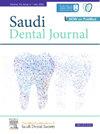利用艾姆斯和彗星试验评估本地生产的纳米羟基磷灰石-硅玻璃离子水泥对人类牙周韧带成纤维细胞的致突变性和 DNA 损伤作用
IF 2.3
Q3 DENTISTRY, ORAL SURGERY & MEDICINE
引用次数: 0
摘要
目的本研究使用艾姆斯和彗星试验评估了一种新型纳米羟基磷灰石-二氧化硅玻璃离聚体水泥(纳米羟基磷灰石-二氧化硅-GIC)和一种传统玻璃离聚体水泥(cGIC)的诱变性和 DNA 损伤。方法在两种 GIC 上分别使用 3.125 毫克/毫升、6.25 毫克/毫升、12.5 毫克/毫升、25 毫克/毫升、50 毫克/毫升、100 毫克/毫升和 200 毫克/毫升的 MTT 法检测人牙周韧带成纤维细胞(HPLF)的细胞活力。在彗星试验中,用 IC50、IC25 和 IC10 的试验材料处理 HPLF,并测量其尾矩。在艾姆斯试验中,采用了鼠伤寒沙门氏菌的四种基因型变异菌株(TA100、TA98、TA1537 和 TA1535)和大肠杆菌的一种菌株(WP2 uvrA)。测试材料用无菌蒸馏水(每毫升 0.2 克)在 37 °C 下提取 72 小时,提取率为 100%,然后用无菌蒸馏水稀释至 50%、25%、12.5% 和 6.25%。将这五种浓度与有代谢活化(S9)和无代谢活化(S9)的细菌菌株以及适当的阳性对照一起培养。结果纳米海藻糖-二氧化硅-GIC 的细胞存活率在 3.125 毫克/毫升时最高(159.4%),而在 200 毫克/毫升时最低(24.26%)。cGIC 的 IC50、IC25 和 IC10 值分别为 95.27、51.4 和 20.1 毫克/毫升,纳米HA-SiO2-GIC 的 IC50、IC25 和 IC10 值分别为 106.9、55.8 和 22.9 毫克/毫升。根据彗星试验,与阴性对照相比,两种试验材料的 IC10 均未显示出明显的 DNA 损伤。结论 根据艾姆斯试验,纳米-HA-SiO2-GIC 不具有致突变性;根据彗星试验,在最低浓度 IC10 时,纳米-HA-SiO2-GIC 不会造成 DNA 损伤。本文章由计算机程序翻译,如有差异,请以英文原文为准。
Mutagenicity and DNA damage assessment of locally produced nano-hydroxyapatite-silica-glass ionomer cement on human periodontal ligament fibroblasts using Ames and Comet assays
Aim
This research assessed the mutagenicity and DNA damage of a novel type of nano-hydroxyapatite-silica glass ionomer cement (nano-HA-SiO2-GIC) and a conventional GIC (cGIC) using Ames and Comet assays.
Methods
Cell viability was tested on human periodontal ligament fibroblasts (HPLFs) using 3.125 mg/ml, 6.25, 12.5, 25, 50, 100 and 200 mg/ml, on both types of GICs employing MTT assay. For the Comet assay, HPLFs were treated with IC50, IC25 and IC10 of test materials and the tail moments were measured. In the Ames test, four genotypic variants of strains of Salmonella typhimurium (TA100, TA98, TA1537 and TA1535) and a strain of Escherichia coli (WP2 uvrA) were employed. The material tested was extracted using sterile distilled water (0.2 g per ml) at 37 °C for 72 h. This was considered as 100 %, which was diluted to 50, 25, 12.5 and 6.25 % utilizing sterile distilled water. These five concentrations were incubated with the bacterial strains with and without metabolic activation (S9), along with appropriate positive controls. The number of revertant colonies was used to evaluate the outcome.
Results
The highest cell viability (159.4 %) for nano-HA-SiO2-GIC was noticed at 3.125 mg/ml, while the lowest (24.26 %) was observed at 200 mg per ml. IC50, IC25 and IC10 values were 95.27, 51.4 and 20.1 mg/ml for cGIC, 106.9, 55.8 and 22.9 mg/ml for nano-HA-SiO2-GIC, respectively. The IC10 of both test materials showed no significant DNA damage compared to that of the negative control based on the Comet assay. The plate treated with nano-HA-SiO2-GIC showed less than double the average number of revertant colonies compared to that of negative control with regard to the Ames test.
Conclusions
It can be concluded that nano-HA-SiO2-GIC is non-mutagenic based on the Ames test and did not cause DNA damage at the lowest concentration of IC10 based on the Comet assay.
求助全文
通过发布文献求助,成功后即可免费获取论文全文。
去求助
来源期刊

Saudi Dental Journal
DENTISTRY, ORAL SURGERY & MEDICINE-
CiteScore
3.60
自引率
0.00%
发文量
86
审稿时长
22 weeks
期刊介绍:
Saudi Dental Journal is an English language, peer-reviewed scholarly publication in the area of dentistry. Saudi Dental Journal publishes original research and reviews on, but not limited to: • dental disease • clinical trials • dental equipment • new and experimental techniques • epidemiology and oral health • restorative dentistry • periodontology • endodontology • prosthodontics • paediatric dentistry • orthodontics and dental education Saudi Dental Journal is the official publication of the Saudi Dental Society and is published by King Saud University in collaboration with Elsevier and is edited by an international group of eminent researchers.
 求助内容:
求助内容: 应助结果提醒方式:
应助结果提醒方式:


